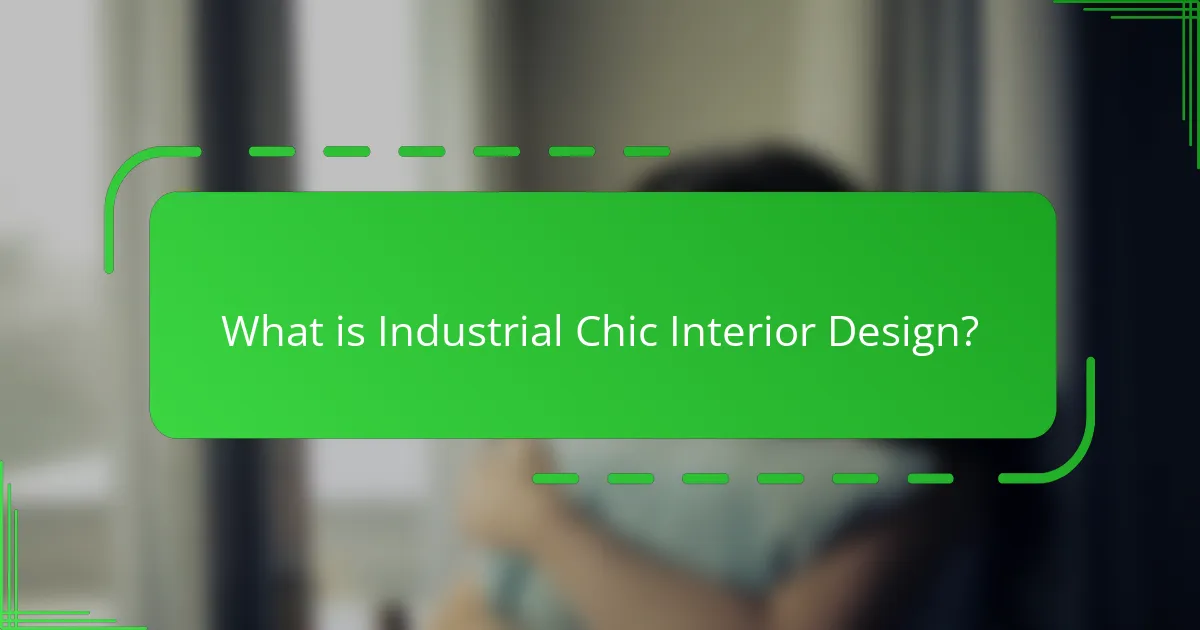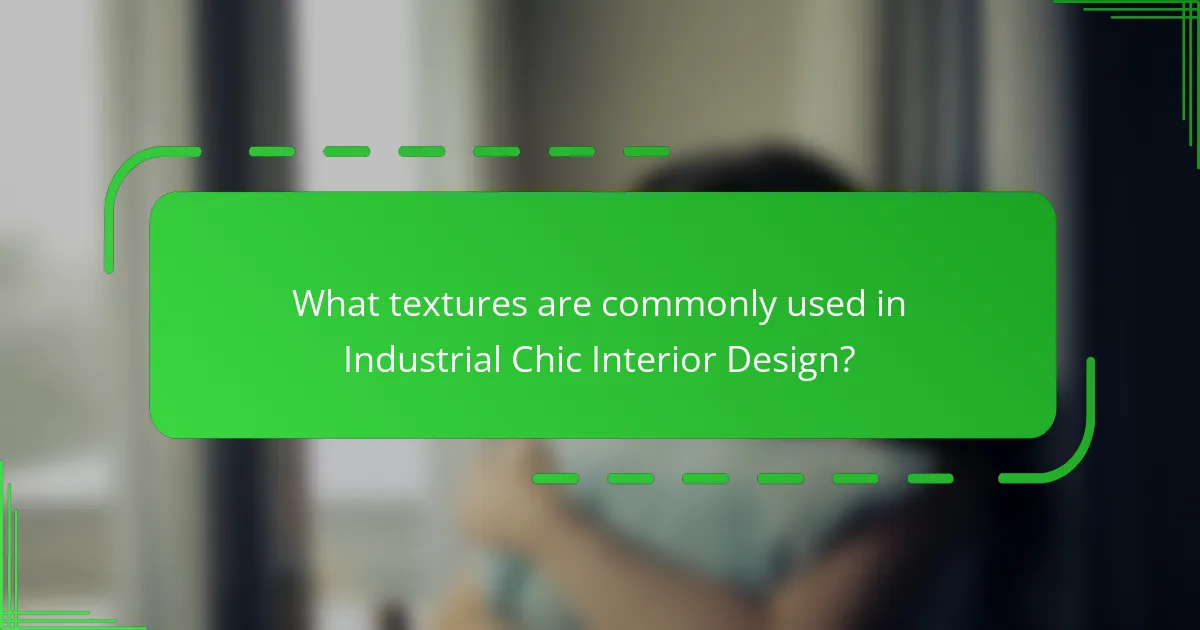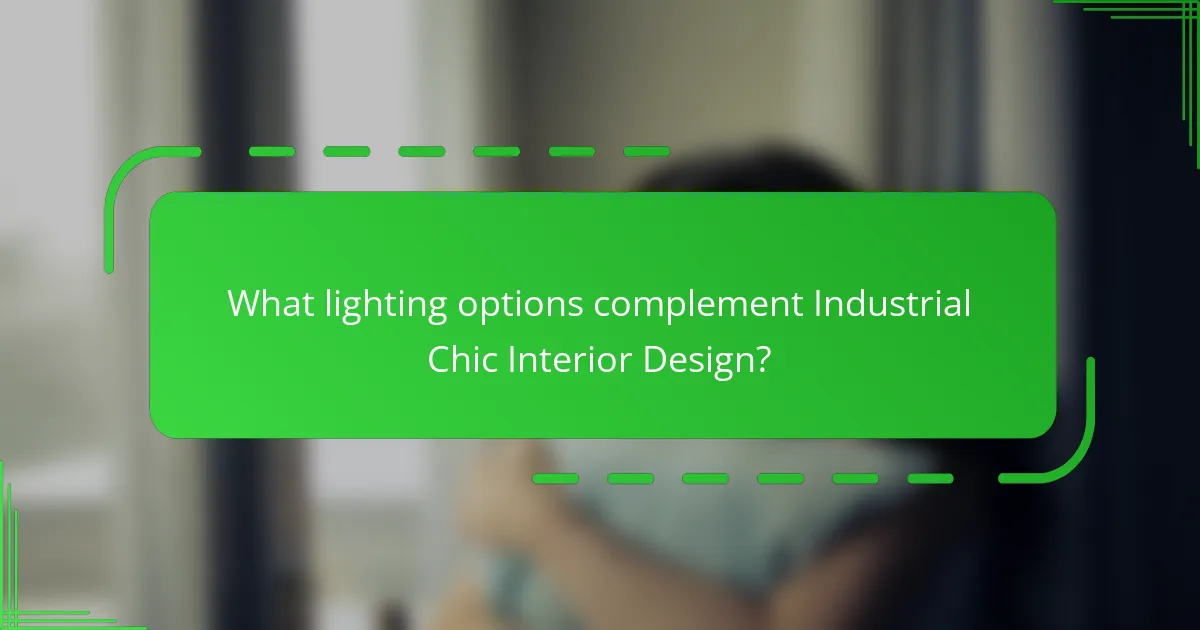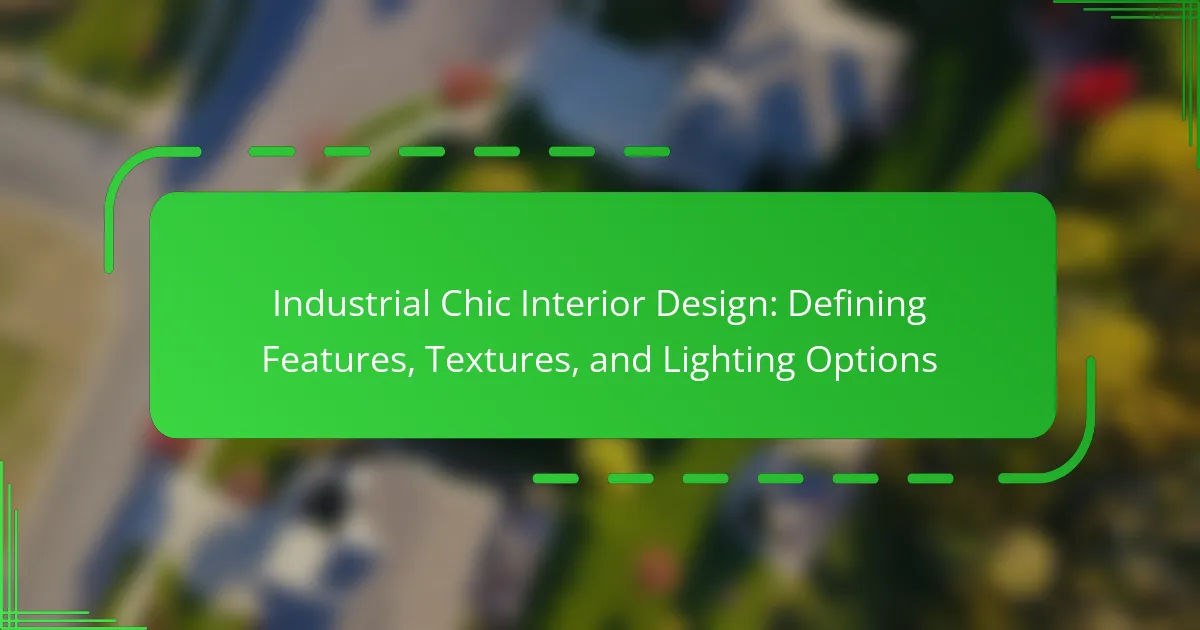Industrial Chic Interior Design is a style characterized by the integration of modern aesthetics with industrial elements, featuring raw materials such as exposed brick, metal, and wood. This design approach is marked by open spaces, high ceilings, and the use of vintage or repurposed furniture. Key textures include exposed brick for warmth, metal finishes for an industrial feel, reclaimed wood for rustic charm, and concrete for a raw appearance. Lighting options, such as exposed Edison bulbs and metal pendant lights, enhance the overall ambiance while serving as design statements. This style, originating in urban lofts and warehouses, appeals to those seeking a unique and edgy environment.

What is Industrial Chic Interior Design?
Industrial Chic Interior Design is a style that blends modern aesthetics with industrial elements. It emphasizes raw materials, such as exposed brick, metal, and wood. This design approach often features open spaces and high ceilings. Furniture typically includes vintage or repurposed items. Lighting is usually minimalistic, with fixtures made of metal or Edison bulbs. The color palette often consists of neutral tones, complemented by bold accents. This style originated in urban lofts and warehouses, reflecting a utilitarian vibe. It appeals to those seeking a unique, edgy environment.
How did Industrial Chic Interior Design emerge?
Industrial Chic Interior Design emerged as a response to urbanization and the repurposing of old factories. In the late 20th century, designers began to embrace raw materials and unfinished aesthetics. This style highlights exposed brick, metal, and wood elements. It gained popularity in cities with industrial backgrounds, such as New York and London. The movement was influenced by the loft living trend, where artists occupied former industrial spaces. Industrial Chic reflects a blend of modern minimalism and vintage charm. Its appeal lies in the juxtaposition of sleek lines with rugged textures. This design continues to evolve, incorporating contemporary elements while maintaining its core ethos.
What historical influences shaped Industrial Chic design?
Industrial Chic design is shaped by historical influences from the Industrial Revolution and mid-20th century urban decay. The Industrial Revolution introduced raw materials like steel and exposed brick into architecture. Factories and warehouses became prominent structures, influencing design aesthetics. Mid-20th century urban decay saw disused industrial spaces repurposed for living and working. This trend embraced the beauty of imperfection and functionality. Artists and designers began to celebrate these elements in their work. The reuse of factory elements in homes became a hallmark of Industrial Chic. This design style reflects a blend of historical utility and modern aesthetics.
How does Industrial Chic differ from other design styles?
Industrial Chic differs from other design styles by emphasizing raw materials and an unfinished aesthetic. This style incorporates elements such as exposed brick, metal fixtures, and reclaimed wood. Unlike traditional styles, Industrial Chic embraces an open floor plan and high ceilings. It often features a mix of vintage and modern furniture. The color palette is typically neutral, focusing on grays, browns, and blacks. This contrasts with more vibrant or ornate design styles. Industrial Chic is rooted in the adaptive reuse of industrial spaces, which sets it apart from residential or classical designs. The style prioritizes functionality and minimalism over decorative excess.
What are the defining features of Industrial Chic Interior Design?
Industrial Chic Interior Design is characterized by a blend of raw materials and modern aesthetics. This style often incorporates exposed brick walls, which add texture and warmth. Open floor plans are common, promoting spaciousness and an airy feel. Metal fixtures, such as steel beams and pipes, are frequently showcased, emphasizing an industrial vibe. Vintage furniture pieces are often integrated, creating a sense of history and uniqueness. Neutral color palettes, with accents of bold colors, enhance the overall design. Large windows allow natural light to flood the space, creating a bright atmosphere. The use of reclaimed wood in furniture and flooring adds sustainability to the design. These features collectively define the Industrial Chic style, merging functionality with artistic expression.
What role do raw materials play in this design style?
Raw materials are fundamental to the Industrial Chic interior design style. They provide an authentic and rugged aesthetic. Common raw materials include exposed brick, metal, and reclaimed wood. These materials contribute to the style’s industrial roots. Their textures add depth and character to spaces. The use of raw materials creates a sense of history and craftsmanship. This design style often highlights imperfections, celebrating the beauty of unfinished surfaces. Overall, raw materials are essential for achieving the distinctive look of Industrial Chic design.
How do open spaces contribute to the Industrial Chic aesthetic?
Open spaces enhance the Industrial Chic aesthetic by promoting a sense of openness and flow. This design style emphasizes raw materials and minimalism. Open layouts allow for the display of structural elements like beams and pipes. Such features highlight the industrial character of a space. The absence of walls creates a more airy and spacious feel. This contributes to a relaxed and inviting atmosphere. Additionally, open spaces facilitate natural light [censured]. This further accentuates the materials and textures typical of the Industrial Chic style. Overall, open spaces are integral to achieving the desired aesthetic.
Why is functionality important in Industrial Chic Interior Design?
Functionality is crucial in Industrial Chic Interior Design because it blends aesthetics with practical use. This design style often incorporates open spaces and multi-functional furniture. These elements enhance the usability of a space while maintaining a visually appealing industrial look. For instance, repurposed materials like metal and wood are not only stylish but also durable and practical. Furthermore, the emphasis on functionality ensures that spaces remain adaptable to various activities, from work to leisure. This adaptability is essential in modern living environments where flexibility is valued. Ultimately, a focus on functionality in this design style supports both comfort and efficiency in everyday life.
How does practicality influence design choices?
Practicality significantly influences design choices by prioritizing functionality over aesthetics. Designers often consider how a space will be used when making decisions. For example, durable materials are chosen for high-traffic areas. This ensures longevity and ease of maintenance. Additionally, layouts are designed to enhance workflow and accessibility. In industrial chic design, practicality leads to open spaces that promote collaboration. The use of reclaimed materials reflects both sustainability and functionality. Overall, practicality shapes decisions that enhance user experience and efficiency.
What are common furniture selections that embody this style?
Common furniture selections that embody Industrial Chic interior design include metal and wood combinations. Items such as reclaimed wood tables are prevalent. They showcase a rustic yet modern aesthetic. Metal chairs with minimalist designs are also popular. These pieces often feature exposed welds or bolts. Industrial-style sofas typically use leather or canvas upholstery. Shelving units made from metal pipes are frequently used for storage. Additionally, vintage industrial stools add character to spaces. These selections reflect the raw, utilitarian vibe of the style.

What textures are commonly used in Industrial Chic Interior Design?
Common textures used in Industrial Chic Interior Design include exposed brick, metal, wood, and concrete. Exposed brick adds warmth and character to spaces. Metal finishes, such as steel or iron, contribute to an industrial aesthetic. Wood elements, often reclaimed, provide a rustic touch. Concrete surfaces are popular for their raw and unfinished look. These textures create a balance between ruggedness and comfort. The combination of these materials enhances the overall design theme.
How do different materials enhance the Industrial Chic look?
Different materials enhance the Industrial Chic look by providing a raw and unfinished aesthetic. Metal elements like steel and iron add strength and durability. They create a modern yet rugged ambiance. Wood, especially reclaimed, introduces warmth and character. It contrasts with the coldness of metal, balancing the overall design. Concrete surfaces offer an industrial feel and are often used for floors and walls. Glass accents contribute transparency and lightness, making spaces feel more open. Textiles like leather add texture and comfort, enhancing the visual appeal. Together, these materials embody the essence of Industrial Chic, creating a cohesive and stylish environment.
What textures are most prevalent in Industrial Chic spaces?
The most prevalent textures in Industrial Chic spaces include raw wood, metal, and exposed brick. Raw wood adds warmth and a rustic feel. Metal surfaces contribute to the industrial aesthetic with their sleek and shiny qualities. Exposed brick walls provide a sense of history and authenticity. Concrete is also commonly used, offering a minimalist and urban vibe. These textures work together to create a cohesive design that emphasizes simplicity and functionality. The combination of these materials reflects the industrial heritage while maintaining a modern appeal.
How do metal and wood combinations create visual interest?
Metal and wood combinations create visual interest through contrasting textures and colors. Metal offers a sleek, reflective quality, while wood provides warmth and organic texture. This contrast enhances the overall aesthetic appeal of a space. For instance, a polished metal table paired with a rustic wooden chair creates a striking visual balance. The interplay of these materials draws the eye and adds depth to the design. Additionally, the combination can evoke a sense of modernity and tradition simultaneously. This duality is a hallmark of industrial chic design, making spaces feel both inviting and sophisticated.
What role do textiles play in Industrial Chic design?
Textiles play a significant role in Industrial Chic design by adding warmth and texture to the otherwise stark aesthetic. They balance the hard, raw materials commonly used, such as metal and concrete. Fabrics like burlap, leather, and wool contribute to a cozy atmosphere. Textiles also introduce color and pattern, which can soften the industrial edges. Their use in cushions, rugs, and curtains enhances comfort without compromising the style’s rugged appeal. Additionally, textiles can reflect the history of the space, connecting modern design with vintage influences. Overall, textiles are essential for creating a harmonious blend in Industrial Chic interiors.
How can soft furnishings balance the hardness of Industrial materials?
Soft furnishings can effectively balance the hardness of industrial materials by introducing warmth and texture. These furnishings, such as cushions, rugs, and curtains, soften the starkness of metal and concrete. The contrast created enhances comfort and visual appeal. Textiles can absorb sound, reducing echo in hard-surfaced environments. Additionally, vibrant colors and patterns in soft furnishings can create focal points. This approach fosters a more inviting atmosphere in industrial spaces. Research indicates that incorporating soft elements can improve mood and well-being. Thus, soft furnishings play a crucial role in harmonizing industrial aesthetics.
What types of fabrics are ideal for an Industrial Chic aesthetic?
Ideal fabrics for an Industrial Chic aesthetic include leather, canvas, and burlap. Leather adds a rugged, luxurious feel and is durable. Canvas offers a sturdy texture that complements industrial elements. Burlap provides a natural, earthy touch that enhances the overall aesthetic. Additionally, denim can contribute to a casual, relaxed vibe. These fabrics align with the raw, unfinished look characteristic of industrial design. Their textures and colors often reflect industrial materials, such as metal and wood. This synergy creates a cohesive and inviting space that embodies the Industrial Chic style.

What lighting options complement Industrial Chic Interior Design?
Industrial Chic Interior Design is complemented by a variety of lighting options. Key choices include exposed Edison bulbs, which enhance the industrial aesthetic. Pendant lights with metal finishes also align well with this style. Track lighting can provide flexibility and highlight architectural features. Additionally, floor lamps with a vintage look contribute to the overall ambiance. Wall sconces made of raw materials further emphasize the industrial theme. These lighting options not only illuminate spaces but also serve as design statements.
How does lighting influence the overall atmosphere in Industrial spaces?
Lighting significantly influences the overall atmosphere in industrial spaces. It can create a sense of openness or intimacy, depending on the design. Bright, even lighting enhances visibility and highlights architectural features. Conversely, softer, ambient lighting can foster a cozy and inviting environment.
The use of task lighting in specific areas can improve functionality without overwhelming the space. Natural light, when incorporated, connects the interior to the outside, enhancing mood and reducing energy costs. Dimmed lighting can also add drama and highlight textures like exposed brick or metal.
Research shows that lighting affects human emotions and productivity. A study by the Lighting Research Center found that well-designed lighting can improve focus and reduce fatigue in workspaces. Thus, lighting is a crucial element in shaping the atmosphere of industrial interiors.
What types of fixtures are commonly used in Industrial Chic design?
Common fixtures used in Industrial Chic design include exposed light bulbs, metal pendant lights, and vintage-style sconces. These fixtures often feature raw materials like steel and iron. They emphasize a utilitarian aesthetic that is characteristic of industrial spaces. Additionally, fixtures may incorporate Edison bulbs for a retro touch. Often, these lighting options are adjustable to enhance functionality. The use of reclaimed materials is also prevalent in fixture design. This approach aligns with sustainable practices in interior design. Overall, these fixtures contribute to the overall industrial ambiance, blending form and function seamlessly.
How can ambient, task, and accent lighting be effectively combined?
To effectively combine ambient, task, and accent lighting, create a layered lighting scheme. Ambient lighting provides overall illumination and establishes the room’s mood. Task lighting focuses on specific areas for activities like reading or cooking. Accent lighting highlights architectural features or artwork, adding depth and interest.
Begin by selecting appropriate ambient lighting, such as ceiling fixtures or wall sconces, to ensure sufficient general light. Next, incorporate task lighting through adjustable lamps or under-cabinet lights in workspaces. Finally, use accent lighting, like spotlights or LED strips, to draw attention to focal points.
This combination enhances functionality and aesthetics. According to the American Lighting Association, proper layering improves both the usability and visual appeal of spaces.
What are the best practices for selecting lighting in Industrial Chic interiors?
Best practices for selecting lighting in Industrial Chic interiors include choosing fixtures that emphasize raw materials. Opt for metal, concrete, or glass materials to align with the industrial aesthetic. Incorporate adjustable lighting to create versatile spaces. Use pendant lights or exposed bulbs to enhance the rugged charm. Layer different light sources for depth and warmth. Consider the scale of fixtures to match the room’s proportions. Utilize dimmers to control ambiance effectively. Finally, ensure that lighting complements the overall design theme for a cohesive look.
How can lighting enhance the textures and features of Industrial design?
Lighting enhances the textures and features of industrial design by creating depth and highlighting materials. It accentuates rough surfaces like concrete and exposed brick, making them visually striking. Different light sources can cast shadows that emphasize the unique shapes of industrial furniture. For example, pendant lights can draw attention to a metal table’s finish. Task lighting can illuminate workspaces, showcasing functional design elements. Ambient lighting can soften the overall look, balancing harsh materials. Additionally, color temperature affects the perception of textures; warm light can make spaces feel inviting. Studies show that effective lighting design can increase the aesthetic appeal of interior spaces, confirming its importance in industrial design.
What practical tips can help achieve an Industrial Chic look?
To achieve an Industrial Chic look, focus on raw materials and open spaces. Utilize exposed brick walls for an authentic industrial feel. Incorporate metal elements like steel beams or iron fixtures. Use reclaimed wood for furniture to add warmth. Opt for minimalist furniture designs with clean lines. Choose neutral color palettes with gray, black, and white tones. Add vintage or retro accessories for character. Use large windows to maximize natural light and enhance the open atmosphere.
How can one effectively mix vintage and modern elements in this style?
To effectively mix vintage and modern elements in industrial chic interior design, start by selecting a cohesive color palette. Neutral tones like gray and beige work well with bold colors. Incorporate vintage furniture pieces, such as a reclaimed wood table or antique light fixtures. Pair these with modern accessories, like sleek metal chairs or contemporary artwork. Use industrial materials, such as exposed brick and metal, to create a backdrop that unifies both styles. Balance the old and new by ensuring that vintage items are not overcrowded by modern elements. This approach creates a harmonious aesthetic that highlights the charm of vintage while embracing modern design principles.
What common mistakes should be avoided when designing an Industrial Chic space?
Common mistakes to avoid when designing an Industrial Chic space include over-cluttering the area with furniture. Industrial Chic emphasizes open spaces that showcase raw materials. Using too many decorative items detracts from this aesthetic. Another mistake is neglecting the balance between hard and soft textures. Combining metal and wood with textiles creates harmony. Additionally, failing to consider lighting is a significant error. Industrial spaces benefit from both natural and industrial-style lighting fixtures. Overly bright or harsh lighting can ruin the ambiance. Lastly, ignoring the color palette can lead to a disjointed look. Sticking to neutral tones with occasional bold accents maintains the style’s integrity.
Industrial Chic Interior Design is a style characterized by the integration of modern aesthetics with industrial elements, featuring raw materials such as exposed brick, metal, and wood. The article explores the emergence of this design style, influenced by urbanization and historical contexts, highlighting its defining features, including open spaces, vintage furniture, and a neutral color palette. Additionally, it examines the role of textures, the significance of functionality, and the impact of lighting choices in creating an inviting atmosphere. Practical tips for achieving this aesthetic and common mistakes to avoid are also discussed, providing a comprehensive overview of Industrial Chic design principles.
